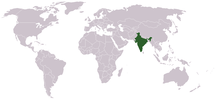tag fix |
FR30799386 (talk | contribs) fixing errors |
||
| Line 8: | Line 8: | ||
|} |
|} |
||
{| border="0" cellpadding="2" cellspacing="2" style="float; margin:.7em" align="left" |
{| border="0" cellpadding="2" cellspacing="2" style="float; margin:.7em" align="left" |
||
| colspan="2" align="center" | [[Image:LocationIndia. |
| colspan="2" align="center" | [[Image:LocationIndia.png|218px|Location on the world map]] |
||
|} |
|} |
||
{| border="0" cellpadding="2" cellspacing="2" style="float; margin:.7em" align="right" |
{| border="0" cellpadding="2" cellspacing="2" style="float; margin:.7em" align="right" |
||
|{{Shortcut|P:IN|WP:PIN}} |
|{{Shortcut|P:IN|WP:PIN}} |
||
|} |
|} |
||
{{Transclude lead excerpt|India|paragraphs=1,2}} |
|||
The [[India|'''Republic of India''']] is a country in, and the namesake of, the [[Indian subcontinent]]. It is bordered by [[Pakistan]] to the northwest, the [[People's Republic of China]], [[Nepal]], and [[Bhutan]] to the north, and [[Bangladesh]] and [[Myanmar]] to the east. India's coastline stretches for over seven thousand kilometers. Its neighbours in the [[Indian Ocean]] are the [[island nation]]s of the [[Maldives]] to the southwest, [[Sri Lanka]] to the south, and [[Indonesia]] to the southeast. India is the [[List of countries by population| second most populated]] [[country]] in the world, with a [[population]] of over [[1 E9|one billion]], and is the [[List of countries by area|seventh largest]] country by geographical [[area]]. It is a constitutional [[republic]], consisting of twenty nine [[states of India|states]] and seven [[union territory|union territories]]. The word ''India'' derives from the [[Old Persian]] cognate for the [[Sanskrit]] word'' [[Sindhu]]'', the [[Indus river]]. The [[Constitution of India]] also recognizes ''Bhārat'' <small>{{Audio|Bharat.ogg|listen}}</small> as an official name with equal status. |
|||
| ⚫ | |||
A centre of important historic trade routes, India is home to the [[Indus Valley Civilization]]. India is the birthplace of four world [[religions]]:[[Jainism]], [[Sikhism]], [[Buddhism]] and [[Hinduism]]. It also has the [[Islam_by_country|third largest Muslim population]] in the world, after Indonesia and Pakistan. Hinduism is the largest religion in India. However, India is a secular country. The country has witnessed significant economic and military growth after the [[liberalization]] of the [[Economy of India|Indian economy]]. India is also well known for upholding the concept of peace, as was demonstrated by its peaceful method of freedom struggle. |
|||
| ⚫ | |||
<div class="noprint" style="text-align:right;margin-right:10px;margin-bottom:4px;">[[Image:Nuvola_filesystems_www.png|16px]] '''[[India|More about India]] ...''' </div> |
<div class="noprint" style="text-align:right;margin-right:10px;margin-bottom:4px;">[[Image:Nuvola_filesystems_www.png|16px]] '''[[India|More about India]] ...''' </div> |
||
Revision as of 14:31, 21 July 2018
 |
 |

|
India, officially the Republic of India (ISO: Bhārat Gaṇarājya), is a country in South Asia. It is the seventh-largest country by area; the most populous country as of June 2023; and from the time of its independence in 1947, the world's most populous democracy. Bounded by the Indian Ocean on the south, the Arabian Sea on the southwest, and the Bay of Bengal on the southeast, it shares land borders with Pakistan to the west; China, Nepal, and Bhutan to the north; and Bangladesh and Myanmar to the east. In the Indian Ocean, India is in the vicinity of Sri Lanka and the Maldives; its Andaman and Nicobar Islands share a maritime border with Thailand, Myanmar, and Indonesia.
Modern humans arrived on the Indian subcontinent from Africa no later than 55,000 years ago. Their long occupation, initially in varying forms of isolation as hunter-gatherers, has made the region highly diverse, second only to Africa in human genetic diversity. Settled life emerged on the subcontinent in the western margins of the Indus river basin 9,000 years ago, evolving gradually into the Indus Valley Civilisation of the third millennium BCE. By 1200 BCE, an archaic form of Sanskrit, an Indo-European language, had diffused into India from the northwest. Its evidence today is found in the hymns of the Rigveda. Preserved by an oral tradition that was resolutely vigilant, the Rigveda records the dawning of Hinduism in India. The Dravidian languages of India were supplanted in the northern and western regions. By 400 BCE, stratification and exclusion by caste had emerged within Hinduism, and Buddhism and Jainism had arisen, proclaiming social orders unlinked to heredity. Early political consolidations gave rise to the loose-knit Maurya and Gupta Empires based in the Ganges Basin. Their collective era was suffused with wide-ranging creativity, but also marked by the declining status of women, and the incorporation of untouchability into an organised system of belief. In South India, the Middle kingdoms exported Dravidian-languages scripts and religious cultures to the kingdoms of Southeast Asia. (Full article...)